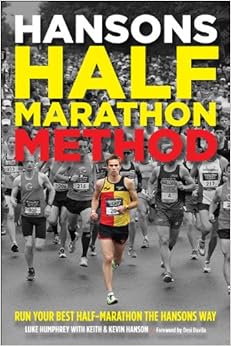This is the second in a series of summaries of the different aspects of
the Hanson's Half Marathon Method I'm using for my fall training. The first was on easy runs.
The Hanson's method defines tempo runs as race pace runs. There's a 1-3 mile warm-up and cool-down and then mileage at goal pace starting at 3 miles (for the beginner plan I'm following) and progressing to 7 miles. The book says: "Internalizing pace is one of the most difficult training components for runners to master....Tempo runs teach you an important skill: control. Even when the pace feels easy, these runs train you to hold back and maintain."
Other benefits to these workouts are testing gear, clothes, and fuel that you plan to use in the race, improving running economy at goal pace, and improving endurance in general.
Race pace runs are part of the Higdon plans I've used in the past so I'm familiar with them. However, I did them differently in my last training. During those pace runs I started feeling like my goal pace, 11:00, was too easy and ran them anywhere between 10:35 and 10:50. Reading what the Hanson's book says above, I realize I was doing it wrong. All I really learned by doing it the way I did was that I could run between 10:35 and 10:50 for up to 7 miles, the longest training run I did at race pace. Now I understand that these training runs are about control, and I really should try to keep to my goal pace consistently because that's what I should do on race day.
The one component of the plan I considered changing was to increase the number of miles at race pace. I would be more confident on race day if I knew I did 8-10 miles at my goal pace in training. But, I've said I'm going to try to follow this plan as closely as I can without changing it, so I'm going to stick to the plan.
One thing I'm going to do differently, though, is to monitor my heart rate during my pace runs. The Pittsburgh Half Marathon taught me that my goal pace can feel much harder on a hot day than in the cold weather in which I'd trained. I think if I ran the Pittsburgh Half by heart rate, I'd have had a much better experience. So I'll be monitoring my heart rate to see what the effort is like at my goal pace in different conditions. I am guessing my effort will be harder at the beginning of training during these hot summer months and get easier as it gets cooler--I hope! I'll then monitor my heart rate during the race to ensure I'm working at the effort level I should be and can make pace adjustments during the race if I need to (which I should have done in the Pittsburgh race!)
I have my first tempo run today (I will in fact be doing it when this post publishes) so I'm curious to see how my goal race pace feels. An 11:00 pace felt so easy all through winter training and was only ever hard on race day because it was so hot. That's why I considered trying for a 10:50 goal pace for this next race. But according to the race equivalency charts based on my 1-mile time trail and most recent 5K this summer, an 11:00 pace is actually a stretch. So I'm going into training with an 11:00 goal pace (actually, 10:59 for an even 2:24 time goal) and see how that feels.
Do you do pace runs in your plan? Do you think they help you on race day? Labels: Hansons Half Marathon Method
